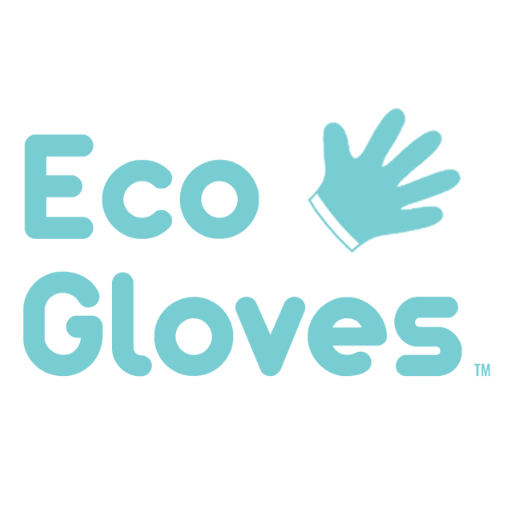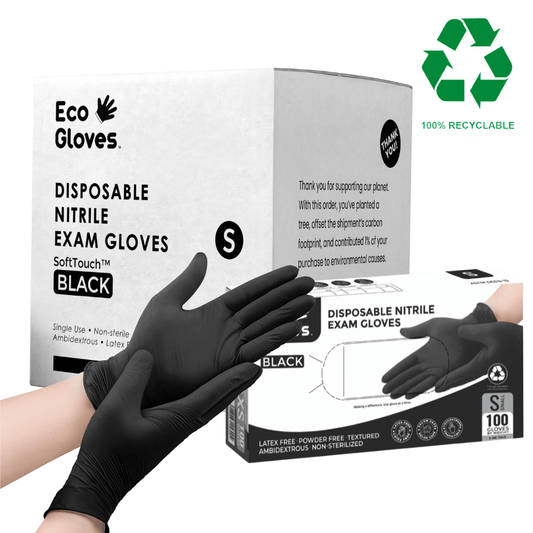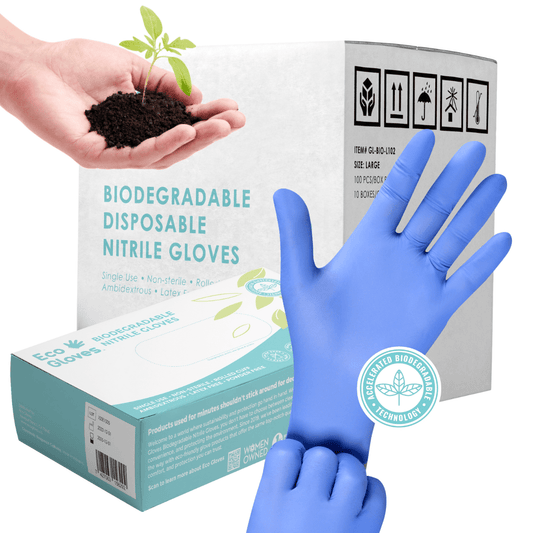Latex vs. Latex-Free Gloves: Which Is Right for Your Business?
Eco Gloves
When selecting disposable gloves for your business, the choice between latex and latex-free gloves is not as simple as comparing prices. It impacts your customers' and employees' safety, your brand’s compliance with health regulations, and even your environmental footprint. With glove usage spanning industries such as medical, food service, cleaning, and beauty, understanding the key differences in glove materials is essential for making informed, responsible purchases.
In today’s business landscape, where personal protection and hygiene are top priorities, selecting the right glove isn’t just practical—it’s a necessity. The wrong choice could lead to allergic reactions, regulatory violations, or subpar performance in critical tasks. This guide will walk you through the differences between latex and latex-free gloves, helping you choose the most suitable option for your industry and values.
Topics Covered
- What Are Latex Gloves? Pros & Cons
- What Are Latex-Free Gloves? Options Available
- Industries and Their Ideal Glove Types
- Eco-Friendly Latex-Free Options
- Bulk Buying Tips: Latex & Latex-Free Gloves
- Matching Gloves to Your Business Needs
- Frequently Asked Questions About Latex vs. Latex-Free Gloves
What Are Latex Gloves? Pros & Cons
Latex gloves are made from natural rubber latex, a biodegradable material derived from the sap of rubber trees. For decades, latex gloves have been widely used in medical, industrial, and cleaning environments due to their superior elasticity and tactile sensitivity.
Pros of Latex Gloves
- Excellent flexibility and comfort: Latex gloves offer a snug, second-skin fit that allows precise movements—ideal for medical procedures or detailed tasks.
- Tactile sensitivity: Especially important in healthcare, where detecting subtle changes in skin texture or performing fine motor tasks is critical.
- Cost-effective: In general, latex gloves are less expensive than premium nitrile gloves.
Cons of Latex Gloves
- Allergy concerns: According to the Journal of Occupational Health, 5–6% of the general population and up to 10% of healthcare workers are affected by latex allergies, ranging from skin irritation to life-threatening anaphylaxis.
- Limited chemical resistance: Latex is not as resistant as nitrile when it comes to certain oils, solvents, and harsh chemicals, which limits its use in industrial settings.

What Are Latex-Free Gloves? Options Available
Latex-free gloves are designed to eliminate the risk of latex allergy and provide alternatives with varying degrees of protection, comfort, and sustainability.
Nitrile Gloves
- Material: Synthetic rubber.
- Strengths: Nitrile gloves are puncture-resistant and offer excellent protection against a wide range of chemicals. They have become the preferred choice in medical, laboratory, and industrial settings.
- Allergy-safe: 100% latex-free, making them suitable for allergy-sensitive environments.
- Durability: Often outlasts both latex and vinyl in high-stress tasks.
Vinyl Gloves
- Material: PVC (polyvinyl chloride).
- Strengths: Economical and suitable for low-risk tasks like food prep or light cleaning.
- Drawbacks: Looser fit and less durable; not suitable for environments requiring high dexterity or protection from pathogens.
Polyethylene, Hybrid & Compostable Gloves
- Material: Lightweight plastics or biodegradable blends.
- Strengths: Ideal for short-term food handling, these gloves are inexpensive and can be environmentally conscious when made from compostable materials.
- Eco-advantage: Options like compostable gloves significantly reduce landfill waste and are a popular choice for environmentally aware businesses.
The Key Differences Between Latex vs. Nitrile vs. Vinyl
When deciding on glove materials, understanding how latex, nitrile, and vinyl compare in function is crucial.
| Feature | Latex | Nitrile | Vinyl |
|---|---|---|---|
| Fit | Snug | Snug | Loose |
| Dexterity | High | High | Low |
| Allergen Risk | High | None | None |
| Chemical Resistance | Moderate | Excellent | Poor |
| Durability | Moderate | High | Low |
| Cost | Moderate | Higher | Lowest |
How to Choose: Questions to Ask for Your Business
1. Do your employees or customers have allergy concerns?
If yes, eliminate latex from your options. Choose nitrile, vinyl, or compostable gloves labeled as non-latex.
2. Do you need chemical or puncture resistance?
Nitrile gloves are ideal for environments like labs, cleaning services, or tattoo parlors where contact with solvents or bodily fluids is common.
3. Will the gloves be used for food handling or medical procedures?
FDA-approved gloves for food handling or medical use must meet stringent standards. Ensure the gloves are food-safe or medical-grade, depending on your application.
4. How important is glove color or appearance for your branding?
Color-coded gloves help avoid cross-contamination in food prep or medical use. They can also be matched to your business’s aesthetic.

Industries and Their Ideal Glove Types
Medical & Dental
Nitrile gloves dominate in medical fields due to their barrier protection and allergy safety. While latex gloves are still used in some facilities, many institutions have phased them out to protect both staff and patients.
Food Service
Vinyl, polyethylene, or compostable gloves are commonly used in restaurants and commercial kitchens. Ensure gloves are certified food-safe. Eco-friendly businesses often prefer compostable options.
Cleaning & Industrial
Durable nitrile gloves are ideal for heavy-duty cleaning or industrial applications due to their chemical resistance.
Beauty & Salon
Nitrile or latex-free gloves are preferred in spas, salons, and tattoo studios, where both tactile sensitivity and hygiene are important.
Eco-Friendly Latex-Free Options
Sustainability is becoming a decisive factor for modern businesses. Traditional disposable gloves—especially vinyl—contribute to environmental waste and pollution. In response, several manufacturers have developed eco-conscious latex-free gloves that biodegrade or are made from compostable materials.
Biodegradable nitrile gloves, for instance, break down faster than standard nitrile in landfills. Compostable gloves made from plant-based materials are another responsible choice for short-duration tasks such as food prep.
By choosing eco-friendly latex-free gloves, businesses not only support sustainability but also attract environmentally conscious customers.
Bulk Buying Tips: Latex & Latex-Free Gloves
Purchasing disposable gloves in bulk is a smart strategy for businesses looking to save money while ensuring an uninterrupted supply. However, it's important to prioritize quality and safety over cost alone.
When sourcing in large quantities, businesses should first verify that gloves meet recognized safety standards such as FDA, CE, or ASTM certifications. These certifications ensure the gloves perform reliably in their intended use, whether in healthcare, food service, or cleaning industries. Proper packaging and storage are also essential to maintain glove integrity, especially in varying climate conditions. Before committing to a large order, it's advisable to request samples to evaluate the gloves' comfort, fit, and durability firsthand.
Most importantly, working with trusted suppliers can make a significant difference. Reputable suppliers offer bulk pricing without sacrificing performance or environmental standards, providing peace of mind along with value.
Matching Gloves to Your Business Needs
Choosing between latex and latex-free gloves depends on your industry, user needs, and sustainability goals. While latex gloves are still used for their comfort and dexterity, the rising concerns about allergies and environmental impact have made latex-free options—especially nitrile and compostable gloves—more popular than ever.
Whether you’re managing a dental clinic, restaurant, cleaning company, or wellness spa, choosing the right glove can enhance safety, ensure compliance, and demonstrate your business's commitment to sustainability.
Ready to make the switch to safer, more sustainable gloves? Explore the full range of latex and latex-free options available at Eco Gloves to find the perfect match for your business needs.
For more glove insights and industry-specific guidance, visit our Eco Gloves Resources.
Key Takeaways: Latex vs. Latex-Free Gloves for Your Business
-
Latex Gloves Offer Comfort & Dexterity – Made from natural rubber, latex provides a snug fit and tactile sensitivity but poses allergy risks to some users.
-
Latex-Free Gloves Eliminate Allergy Concerns – Options like nitrile, vinyl, polyethylene, and compostable gloves are safer for sensitive skin and allergy-prone environments.
-
Nitrile is the Top Performer for Protection – Synthetic, puncture-resistant, and chemically durable, nitrile gloves are ideal for healthcare, industrial, and cleaning applications.
-
Vinyl & Poly Gloves for Light-Duty Tasks – Cost-effective and latex-free, these gloves work for food service or low-risk applications but lack heavy-duty durability.
-
Eco-Friendly Options are Growing – Biodegradable nitrile and compostable plant-based gloves reduce environmental impact while meeting safety standards.
-
Industry-Specific Choices Matter – Match glove type to industry needs: nitrile for healthcare/cleaning, compostable for eco-focused food service, and vinyl for low-risk handling.
- Bulk Buying Saves, but Quality Comes First – Always verify FDA, CE, or ASTM certifications before purchasing in large quantities to ensure safety and compliance.
👉 Choosing the right glove type protects your staff and customers, supports compliance, and can help meet your sustainability goals.
Frequently Asked Questions About Latex vs. Latex-Free Gloves
-
Are latex-free gloves safer for sensitive skin?
Yes. Latex-free gloves, such as nitrile, vinyl, and compostable options, reduce the risk of allergic reactions.
-
What’s the main difference between latex and nitrile gloves?
Nitrile gloves are synthetic, allergy-safe, and offer better chemical resistance. Latex gloves are natural, highly flexible, and tactile, but can cause allergies.
-
Are vinyl gloves always latex-free?
Yes. Vinyl gloves are made from PVC and are a latex-free choice for short-duration, low-risk tasks.
-
Can latex-free gloves be used in hospitals or food service?
Absolutely. Nitrile is widely used in healthcare, and compostable or vinyl gloves can be food-safe when certified.
-
Which glove type is best for chemical resistance?
Nitrile gloves provide the highest resistance to oils, solvents, and many harsh chemicals.
















